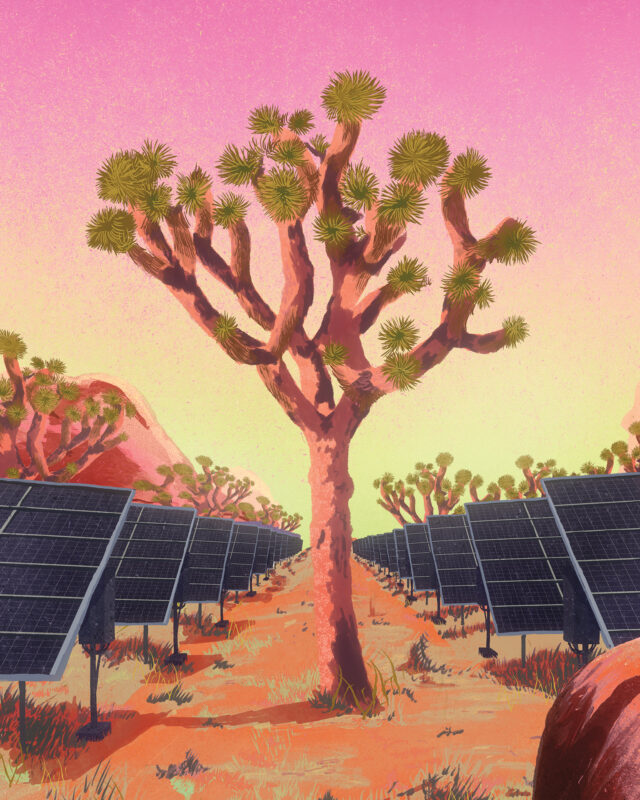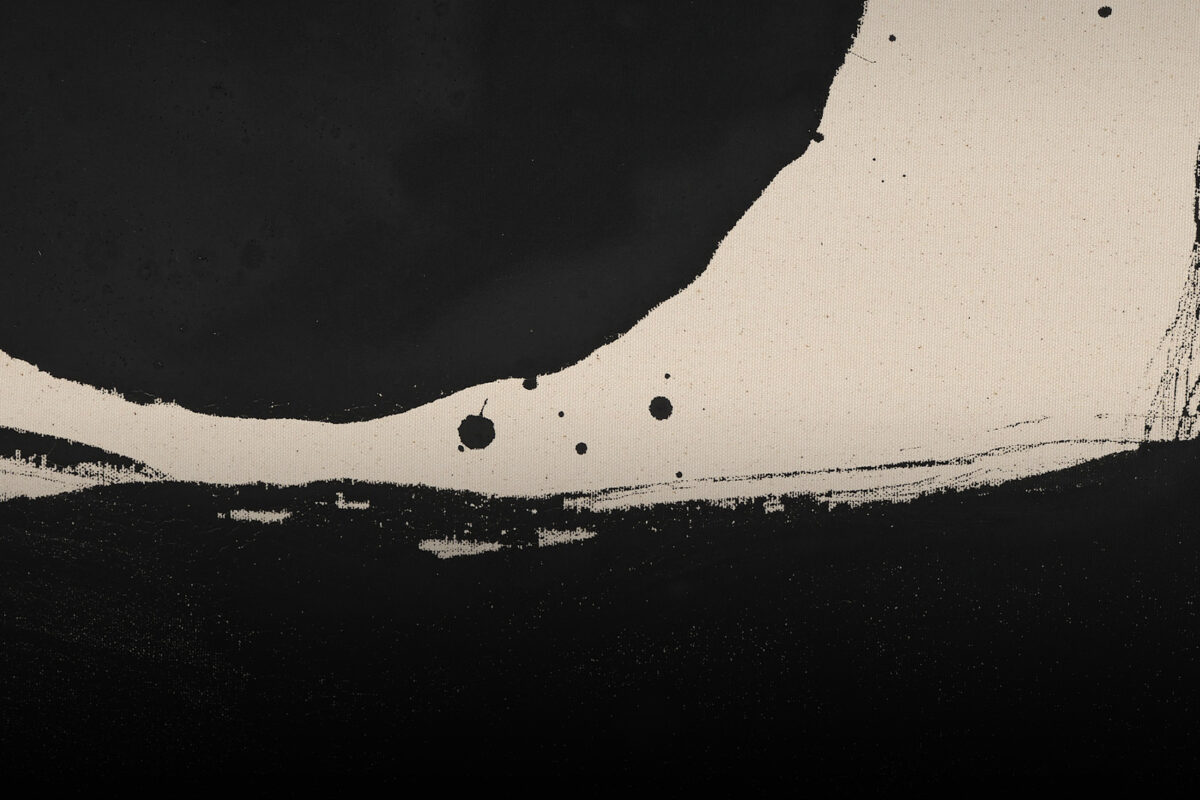Despite state protections, the imperiled Joshua tree is battling power-hungry humans and a hostile climate
Words by CHRISTINE LENNON
Illustration by ADOLFO CORREA

Joshua trees, those spiky, Seussian succulents found only in the higher elevations of the Mojave Desert, are inextricably linked to the history, mythology, and struggles that define the Southern California experience. Inspired by the story of Joshua guiding Israelites through Canaan with outstretched hands, mid-19th-century Mormon settlers nicknamed Yucca brevifolia, and it’s fitting that the label stuck. Conservationists revere the trees with an almost religious devotion, and the challenges to their survival — which started almost as soon as industrialists began turning their stalks to pulp for desert paper mills in the 1870s — are biblical in their scope and severity.
Wildfires have wiped out thousands of acres of Joshua tree habitat, and the Dome Fire in 2020, caused by lightning strikes, took out a million trees in a matter of hours. Climate change has gradually altered the temperature of their narrow growing zone to the point where it’s no longer cool enough to reach the temperature the trees need to reproduce successfully. Transplanting them is a painstaking and expensive task because they depend on both a single moth species for pollination and a vast underground network of fungi and microorganisms to survive. And developers have razed them for decades, making room for projects as mundane as tract housing and as necessary as solar energy plants.
“If we chose to do absolutely nothing to protect the Joshua trees, just went about our business as usual, they could have as little as 100 years left,” says Cameron Barrows, a retired research ecologist at the University of California Riverside Center for Conservation Biology. Barrows was the principal investigator in determining whether the trees were imperiled by climate change in the national park that bears their name.
Over the past year, two headline-worthy events have put the plight of the Joshua tree at the center of California’s cultural conversation. The first occurred in July 2023, when Governor Gavin Newsom signed the Western Joshua Tree Protection Act to guard the endangered tree permanently and prohibit their sale, transfer, or removal without the permission of the California Department of Fish and Wildlife.
“Part of the goal of seeking and gaining statewide protection was to tilt the regulatory scales so it no longer was cheaper and easier to build on a Joshua tree woodland than it would be on less sensitive lands,” says Brendan Cummings, an environmental litigator and conservation director at the Center for Biological Diversity. Cummings has worked for years on writing and passing this legislation. “When this project was started, was proposed, and got early permits, essentially Joshua trees were given little if any value in the balance of where to build.”
Just shy of a year later, California-based Avantus Power broke ground on the controversial Aratina Solar Center on 2,300 acres in Kern County that was greenlit before the legislation was in place. It’s a massive renewable energy plant that will provide power for 180,000 homes in the Bay Area. Activists protested the health hazards of the long, dusty construction project and the environmental impact on the hundreds of plant and animal species — including 3,500 Joshua trees — that were destroyed or lost their homes when the land was cleared in June.

“Solar companies have been invited in the desert, going back to the Obama era when the president was trying to collectively encourage the development of solar energy,” Barrows says. “Part of that movement was because it’s really sunny in the desert, and part of it was that there is a perception in Washington and on the East Coast that the desert is, by and large, not very biologically diverse. Part of the research we’ve been doing is to make it very obvious that there are more animals and plant species in the desert than any other region of California. No one would propose cutting down redwoods to create clean energy. And the desert is equally if not more biodiverse than a redwood forest.”
A third newsworthy event is happening this September, when the long-awaited PST ART: Art & Science Collide opens in 60 museums and cultural institutions across the region. One exhibit curated for the Lancaster Museum of Art and History, titled Desert Forest: Life With Joshua Trees, is a cross-disciplinary project that integrates natural history, Indigenous knowledge, public policy, scientific research, and artistic expressions to emphasize the challenges facing the Joshua tree and conservation efforts.
The lead curator, Sant Khalsa, is an artist and educator who spent 30 years teaching at Cal State San Bernardino and has been a lifelong advocate for desert conservation. Khalsa also edited a book with contributions from artists like Ed Ruscha, which will be published in conjunction with the exhibition.
Khalsa was assisted by Juniper Harrower, a professor at Reed College in Oregon and a native of the town Joshua Tree. Harrower is both a fine artist and a scientist who specializes in multispecies entanglements under climate change, and she has exhibited her work with Joshua trees all over the West. One of her more memorable creations is a “dating site” called Hey J Tree that matches budding conservationists with trees at various research sites. Through a multimedia art and science research practice, she considers the ways that humans influence ecosystems while seeking solutions that protect at-risk species and promote environmental justice. The MOAH exhibition in Lancaster will include an outdoor reforestation project and a greenhouse that demonstrates how Harrower and her students are working to repopulate the species.
“When these major forest fires happen and we lose thousands of Joshua trees, groups like the National Park Service will go and transplant these baby trees. Then 90 percent of them will die,” Harrower says. The aforementioned climate conditions and root-eating rodents are part of the problem, but Harrower’s research revealed that there is a mycorrhizal fungal network in the soil around Joshua tree forests, and the trees are unlikely to thrive without this symbiotic support system. To address the problem, Harrower is working on planting containers that simulate the natural conditions necessary for the trees to thrive.
“I’m growing mycelium containers out of a fungus with bio waste and a slow degrading netting within these containers. They’re responsive to Joshua tree roots, and we’re trial planting them out in the desert,” she says. “We’ve been prototyping the nurse-plant containers for a few months now, and some of them will be on display at MOAH.”
“If we do nothing to protect the Joshua trees, they could have as little as 100 years left”
Scientists, environmental lawyers, and activists have been straining against local government officials who welcome development and the energy-industry tax dollars they bring to their communities. An equally daunting threat may be the public relations machine behind big energy companies, which promote the idea that the only viable land for massive solar energy complexes also happens to be home to these critically endangered species. Because of the Joshua tree habitat’s proximity to existing power grids, it’s more economical to build the solar plants on that land.
“That is definitely a lie,” says Barrows. “There are options. For example, tens of thousands of acres in the desert were designated for agriculture that’s not sustainable. We don’t have the water to support alfalfa [and other crops]. We just don’t. Some of that land has already been abandoned, and a lot of it is about to be. There is more fallow land than we will ever need to produce solar energy.”
If the electrons produced from desert-based energy sources can travel many hundreds of miles to power-hungry communities along the coast, critics say it’s possible for solar facilities to be connected to the grid from a distance of a few miles. Cummings, whose profession necessitates putting an optimistic spin on grim statistics, says that the attention this Aratina solar plant is attracting is ultimately good news for climate policy.
“It’s interesting which project gets the attention,” says Cummings, who notes that there are several “shovel-ready” solar projects in the works in the desert that were permitted before Joshua tree protections passed last year. Now that the basic law is in place, supported by irrefutable science and the attention of the general public, there is hope.
In 2004, while he was working on the Endangered Species Act petition for the polar bear, Cummings discovered that it was possible to protect a single species from climate change.
“I was looking out of my office window at Joshua trees while I was writing about polar bears,” he says. “In that case, the mechanism was obvious: Climate change melts ice, making it impossible for them to hunt, so they starve to death. It’s simpler to understand.” With Joshua trees, it took more time to connect the dots between climate change and an increase in wildfires, as well as the slight temperature variations that make tree reproduction impossible.
The legal protections in place are imperfect, and some say the fines developers must pay when they destroy Joshua trees to create Airbnbs aren’t high enough to deter building. But it’s a good start.
“Right now, the model we’ve got is capitalist-driven species conservation,” Harrower says. “It’s how society works around environmental governance. The policy is so critical to protect the trees, but it has to work in conjunction with major cultural shifts. Right now we’re just throwing a lot of Band-Aids out there to save the species that we can.”
Although there’s no doubt that difficult compromises are inevitable in the movement toward a zero-emissions future, the acknowledgment that the desert is not a barren wasteland is an integral step toward making more informed and sensitive decisions about how to achieve that goal.
“It’s a shift,” Cummings says. “There aren’t many species that have their own law of protection, and the Joshua tree is one of them.”

This story originally appeared in the Fall 2024 issue of C Magazine.
Discover more CULTURE news.
See the story in our digital edition



